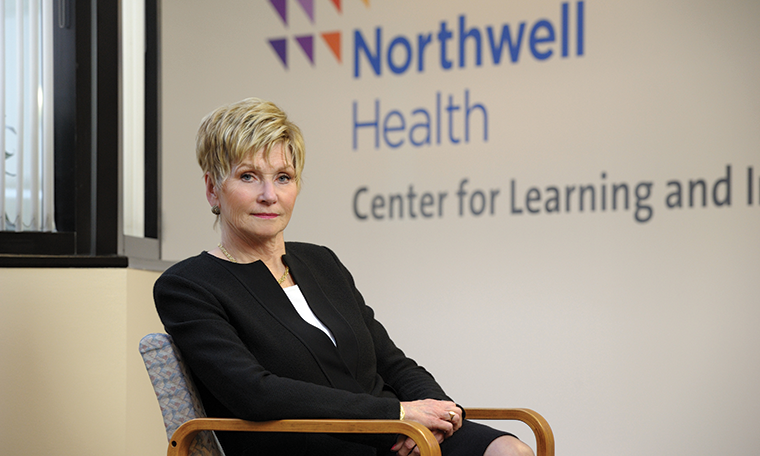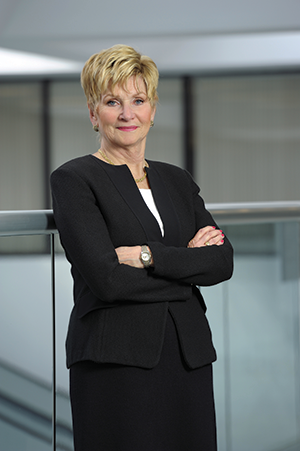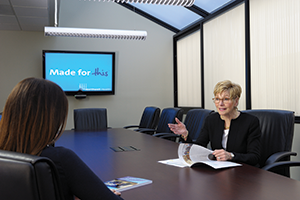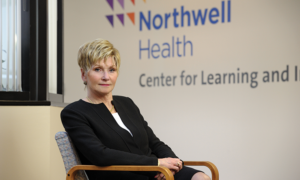
When Michael Dowling was promoted to CEO of Northwell Health in 2002, one of his first moves was to lay out plans for a new learning center to support the fast-growing health care network in New York state.
by Sarah Fister Gale
June 19, 2018

When Michael Dowling was promoted to CEO of Northwell Health in 2002, one of his first moves was to lay out plans for a new learning center to support the fast-growing health care network in New York state. He envisioned a corporate campus where the health care system’s now 63,000 employees could take part in continuous learning opportunities and develop the knowledge, skills and experience they needed to help the health care network thrive.
“I have always believed in the importance of creating a culture of continuous learning,” Dowling said. “If you don’t, you will get left behind.”
With that vision in place, Dowling set out to find someone to make it happen. “I didn’t want a traditionalist who would replicate what others had already done,” he said. “I wanted someone with a fresh view who could be a change agent.”
He chose Kathy Gallo, a seasoned trauma nurse, who at the time was overseeing emergency medical services for the health care network and helping to build strategies for all of its trauma centers. Gallo, who had been with the organization since the mid-1990s, had no formal experience in learning and development. However, she did have a big reputation as someone who could get things done. “That’s why I wanted her,” Dowling said. “Kathy has a presence about her and she’s not afraid of bureaucracy.”
Dowling promoted her to senior vice president and chief learning officer reporting directly to him. Then he gave her a white paper laying out his visions for a Center for Learning and Innovation, or CLI, and publicly announced that Northwell would partner with GE and the Harvard School of Public Health to make it happen. “Once you announce something to the world you have to do it,” he said.
Deadly Errors
Gallo set to work developing plans for what would become a world-class learning center — though its first iteration was fairly humble.
In late 2002, she began by offering management courses and Six Sigma training in a small rented classroom near the network’s headquarters in Great Neck, New York. For the first few years Gallo focused on management training, offering classroom and online courses focused on workforce development and organizational leadership. “We still offer many of the courses today,” she said. But over time, the center expanded, in large part because Gallo’s team was constantly looking beyond traditional classroom lectures to find more innovative ways for employees to learn in a collaborative and cross-functional environment.
She knew clinical training would be fundamental to the success of the program, and she tied her training strategy to a 1999 paper from the Institute of Medicine. The report, “To Err is Human: Building a Safer Health System,” found that as many as 98,000 hospital deaths per year were due to preventable medical errors. “We were all taken aback by those numbers,” Gallo said. She also knew that as head of CLI she had an opportunity to reverse that trend.

As a clinician herself, Gallo knew that many high-risk medical scenarios only happen on rare occasions, forcing staff to react instantly under extreme pressure and to perform interventions they may have little or no experience with. Further, she was frustrated by the fact that clinicians are rarely taught in cross-functional teams, even though that is how care is delivered and health care decisions are made. “Many errors are caused by a lack of teamwork,” she said.
She believed that if clinical staff could jointly experience and practice these high-risk medical emergencies in a safe environment, they would be better prepared when the real thing happened. “Any event that can cause harm should be practiced over and over, so that the moment it happens you know what to do.”
Lessons Learned from JetBlue
Gallo’s idea for simulation-based training was unheard of in health care at the time, but it was becoming a popular tool in the aviation industry. So Gallo reached out to the CLO of JetBlue, which was using simulation-based training to teach pilots and staff how to respond in emergencies. The JetBlue learning organization helped Gallo’s team design a simulation training center mimicking their own aviation training environment but with a focus on clinical staff.
In 2005, with full support from Dowling, Gallo opened the Patient Safety Institute, an academic center developed and owned by Northwell Health. Then she partnered with Northwell’s HR team and several clinical thought leaders from across the organization to develop a series of team-focused simulation-based courses. The institute grew at such a rapid rate, in 2010 it opened its current 40,000-square-foot facility.
The Patient Safety Institute features 13 simulation suites where students practice medical scenarios in a simulated environment complete with digital screens, medical equipment and high-fidelity simulators. The simulators can talk about their symptoms and simulate anything from a heart attack to heart murmurs, labored breathing, fever and other symptoms. The course leaders design each medical scenario, then watch through a one-way mirror as staff respond to the event.
The use of high-fidelity simulators and virtual scenarios is exciting, though learning in a team environment was also something new for Northwell staff, said Joe Moscola, head of HR. Each lesson involves a team of staff who work collaboratively to address the medical scenario. Everyone is held accountable for the patient outcome and for participating in care decisions, Moscola said. “It builds a culture of teamwork where everyone finds their role.”
It also helps flatten the traditional hierarchy that dominates most health care environments where doctors are viewed as the final voice of reason and support staff are wary of pointing out mistakes. “When everyone learns to speak up it keeps mortality rates low,” Moscola said.
Gallo noted that these simulation-based courses don’t solely address medical interventions. The Patient Safety Institute also offers a series of simulated training sessions focusing on communication strategies, including how to give patients bad news, how to talk to families about end-of-life care, and how to talk about sexual assault, shootings and other traumatic events. These simulations often include human actors playing the role of the family or patient. “Sitting with family members in these situations can be very dramatic, and mastering those conversations takes practice,” Gallo said.

Once a simulation is completed, all of the class participants meet with the course leader to debrief what happened. “In hospitals, you rarely get the chance to reflect on what occurred,” Gallo said. But in the simulation center the debrief is the most important part and it takes up 80 percent of the learning time. During debriefs, the students and staff watch a video of the simulation and talk about what happened, how they felt, what they missed and what they would do differently. “The conversations we have are remarkable,” Gallo said. “That’s where the learning happens.”
Sepsis and Organ Donation
Gallo admitted that early on, not everyone was eager to attend classes at the simulation center. “A lot of people were still glued to the old PowerPoint lecture model,” she said. But she and her team sought out champions in each department to try the courses and to promote them to their teams. “Once they started to talk about the value of simulation for learning, word spread,” she said.
Today, CLI has no problem attracting employees to courses, even though none of them are required. Last year, CLI and the Patient Safety Institute served more than 60,000 participants who spent a collective 250,000 hours in training. These include Northwell staff, as well as employees from General Electric, the FBI, the Air National Guard, and the Bureau of Alcohol, Tobacco, Firearms and Explosives, among others.
“The biggest challenge we have now is how to accommodate everyone,” Gallo said. The team is constantly rolling out new programs, often in response to initiatives in the health care network to address a problem. For example, in 2012, Dowling challenged the network to reduce the incidence of sepsis — a life-threatening complication of an infection — by 50 percent in five years. In response, CLI developed the Taming Sepsis Education Program, a case-study-based online learning course to identify signs of sepsis followed by a simulation course. The program, along with other changes in the way Northwell looks for signs of sepsis, helped the network meet the 50 percent goal by 2017.
Gallo went on to write a textbook on her experiences creating CLI, “Building a Culture of Patient Safety Through Simulation.” She is also now the founding dean of the Hofstra Northwell School of Graduate Nursing and Physician Assistant Studies, which opened in 2015. Going forward, she plans to expand the graduate nursing and physician assistant school and open CLI to more members of the education and business communities.
https://youtube.com/watch?v=7zDPtzz-5pY
A Hidden Gem
Dowling and the rest of the leadership team at Northwell feel lucky to have found Gallo and rely on her to help solve whatever health care challenge or leadership issue arises. Whether it’s reducing rates of infection, improving health care outcomes or addressing turnover among certain groups of employees, Gallo is always there to help, Moscola said. “Whenever someone comes to her with a problem she figures out a way to solve it.”
She also has a knack for eliminating conflict, said Jason Naidich, senior vice president and executive director of Northwell’s central region. “She creates an inclusive environment that brings people together,” he said.
He attributes her success and the success of other leaders at Northwell in large part to the culture of continuous learning that Dowling and Gallo have built. “Northwell always looks internally to find talent, and CLI helps nurture that talent so people can succeed in those roles,” Naidich said.
He noted that many organizations fail to find hidden gems like Gallo because they are too set on finding people who have exactly the right résumé or set of experiences. “Kathy is a great example of what can be done when you give someone with potential the right tools and the opportunity to build something new.”
Sarah Fister Gale is a writer based in Chicago. She can be reached at editor@CLOmedia.com.




